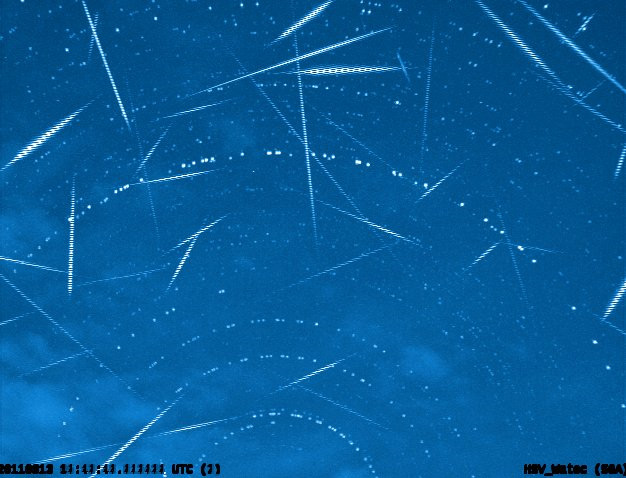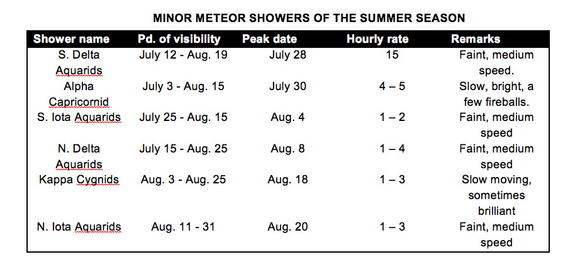Summer Streakers: How to Catch the Upcoming Meteor Showers

For Northern Hemisphere observers, the latter half of July and on into August is usually regarded as "meteor viewing season," with one of the best displays of the year reaching its peak in mid-August. That display, of course, is the annual Perseid Meteor Shower beloved by everyone from meteor enthusiasts to summer campers.
The year 2012 will be a fair-to-good one for viewing the Perseids, as they coincide with a waning crescent Moon that will prove to be more of a nuisance than an outright hindrance for prospective observers.
This week, however, we'll concentrate on some of the lesser-known summer meteor displays.
Meteor season
In general, the Earth encounters richer meteoric activity during the second half of the year. You're also more likely to see twice as many meteors per hour in the predawn hours as compared to the evening hours. This is due to the fact that during the pre-midnight hours we are on the "trailing" side of the Earth, due to our orbital motion through space. [2012 Meteor Shower Skywatching Calendar]
Any meteoric particle generally must have an orbital velocity greater than that of the Earth to "catch" us and hit our planet's atmosphere. However, after midnight when we are turned onto the Earth's "leading" side, any particle that lies along the Earth's orbital path will enter our atmosphere as a meteor.
As such objects collide with our atmosphere at speeds of 7 to 45 miles per second, their energy of motion rapidly dissipates in the form of heat, light, and ionization, creating short-lived streaks of light popularly referred to as "shooting stars."
Sign up for the Live Science daily newsletter now
Get the world’s most fascinating discoveries delivered straight to your inbox.
Summertime meteors, occasionally flitting across your line of sight, are especially noticeable between mid-July and the third week of August. And between Aug. 3 and Aug. 15, there are no fewer than six different minor displays that are active. These six are listed in the table below.

Viewing tips
To view meteor showers, the only equipment you'll need are your eyes and a modest amount of patience.
The actual number of meteors a single observer can see in an hour depends strongly on sky conditions. The rates given in the table are based on a limited star magnitude of +6.5 (considered to be the faintest star visible to the naked eye without the use of binoculars or a telescope in a really clear sky), an experienced observer, and an assumption that the radiant is directly overhead. The radiant is the point in the sky where the paths of shower members, if extended backward, would appear to originate when plotted on a star chart.
Your clinched fist held at arm's length is equal to roughly 10 degrees on the sky. So if the radiant is 30 degrees ("three fists") above the horizon, the hourly rate is halved; at 15 degrees it is one-third.
While the hourly rates from these other meteor streams provide but a fraction of the numbers produced by the Perseids, combined they provide a wide variety of meteors of differing colors, speeds and trajectories.
Among these are the Southern Delta Aquarids, which can produce faint, medium-speed meteors; the Alpha Capricornids, described as "slow, bright, long trailed yellowish meteors" and the Kappa Cygnids, which are classified as "slow moving and sometimes producing brilliant flaring fireballs." As such, if you stay out and watch long enough, you may be nicely rewarded for your time spent.
Note that five of the six meteor showers listed come from the region around the constellations of Aquarius and Capricornus. These constellations are highest in the southern sky between roughly 1 and 3 a.m. local daylight time. The Kappa Cygnids appear to emanate from the constellation Cygnus, which will appear more or less overhead within an hour of local midnight.
Currently the one drawback in watching for meteors is the moon, which will reach full phase on Aug. 1.
Since it will be in the sky practically the entire night, the moon's brilliant light will likely obscure all but the very brightest meteor streaks. But as the summer progresses, the moon will be rising progressively later in the night as well as waning in phase and brightness. After Aug. 10, the moon will have diminished to a crescent phase and will become significantly less of a hindrance to viewers.
This story was provided by SPACE.com, a sister site to LiveScience. Joe Rao serves as an instructor and guest lecturer at New York's Hayden Planetarium. He writes about astronomy for The New York Times and other publications, and he is also an on-camera meteorologist for News 12 Westchester, New York.












